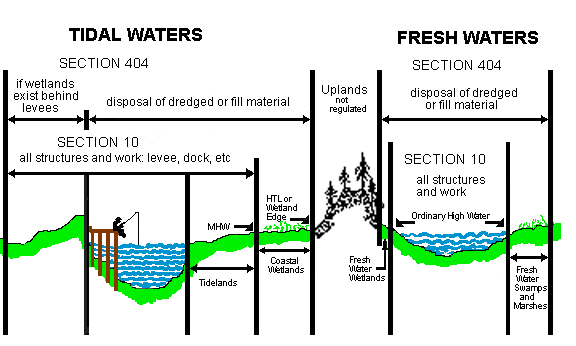Definition of Waters of the U.S.
Limits of jurisdiction:
-
Territorial Seas. The limit of jurisdiction in the territorial seas is measured from the baseline in a seaward direction a distance of three nautical miles. (See 33 CFR 329.12)
-
Tidal (Navigable) Waters of the U.S. The landward limits of jurisdiction in tidal waters:
Extends to the high tide line, or
When adjacent non-tidal waters of the United States are present, the jurisdiction extends to the limits identified for Non-Tidal Waters of the U.S.
-
Non-Tidal Waters of the United States. The limits of jurisdiction in non-tidal waters:
In the absence of adjacent wetlands, the jurisdiction extends to the ordinary high water mark, or
When adjacent wetlands are present, the jurisdiction extends beyond the ordinary high water mark to the limit of the adjacent wetlands.
When the water of the United States consists only of wetlands the jurisdiction extends to the limit of the wetland.
-
Typical examples of regulated activities:
- Section 404 - Disposal of Dredged or Fill Material into Waters of the U.S.
All filling activities, utility lines, outfall structures, road crossings, beach nourishment, riprap, jetties, some excavation activities, etc.
- Section 10 - All Structures and Work.
Dredging, marinas, piers, wharves, floats, intake/outtake pipes, pilings, bulkheads, ramps, fills, overhaed transmission lines, etc.
- Section 103 - Ocean Discharge of Dredged Material
(section view)

Recent Court Decisions that have affected Corps Jurisdiction:
-
Under the Supreme Court’s decision in Solid Waste Agency of Northern Cook County v. United States Army Corps of Engineers, 531 U.S. 159 (2001), directed that the U.S. Army Corps of Engineers does not have jurisdiction over isolated, intrastate, non-navigable waters under 33 C.F.R. § 328.3(a)(3), based on their use as habitat for migratory birds pursuant to preamble language commonly referred to as the “Migratory Bird Rule,” 51 Fed. Reg. 41217 (1986).
-
The U.S. Environmental Protection Agency and U.S. Army Corps of Engineers issued
agency guidance regarding Clean Water Act (CWA) jurisdiction following the U.S. Supreme Court’s decision in the consolidated cases
Rapanos v. United States and
Carabell v. United States (“Rapanos”). The agencies have issued this guidance to ensure that jurisdictional determinations, administrative enforcement actions, and other relevant agency actions being conducted under the CWA are consistent with the Rapanos decision and provide effective protection for public health and the environment. An Approved Jurisdictional Determination Form must now be completed by Corps personnel for all delineations verified by the Corps. To ensure rapid and accurate evaluation of materials prepared by the applicant, the Corps requests proposed maps and supportive documentation supplied for jurisdictional determinations and delineations be submitted in a standard format. Please see the attached document for a
list of requested information for verification of Corps' jurisdiction.